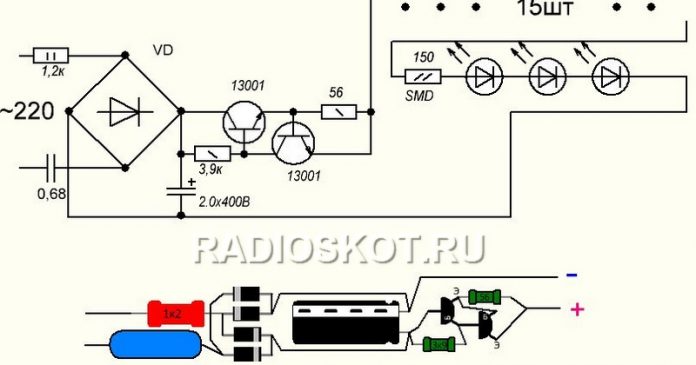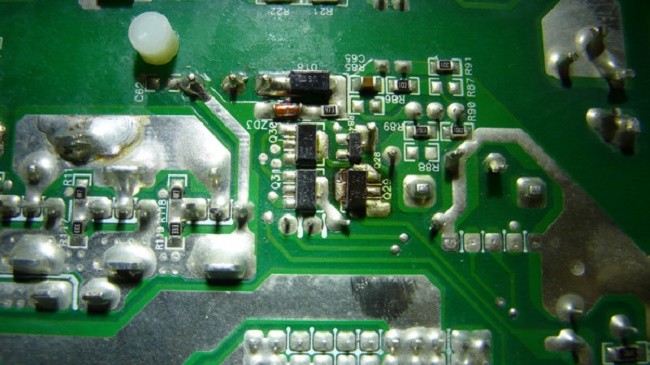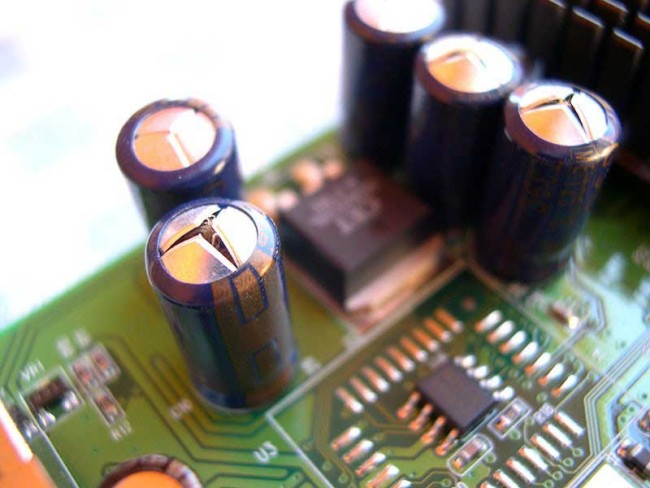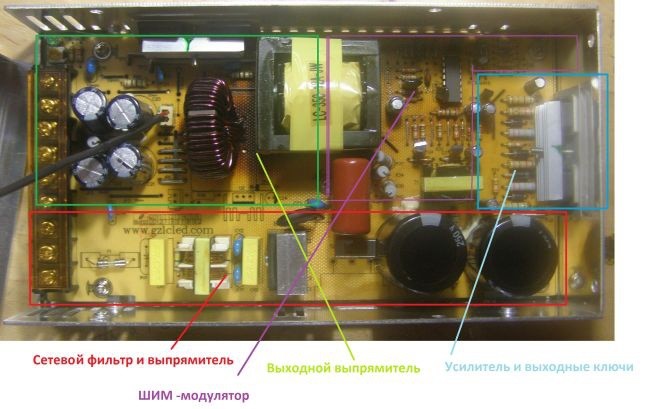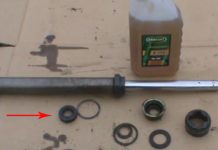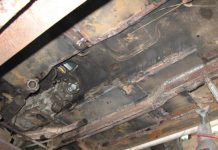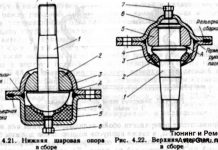In detail: DIY LED strip repair from a real master for the site my.housecope.com.
LED strips are widely used in decorative lighting and functional lighting, but from time to time they fail completely or partially, in this regard, it becomes necessary to repair or replace them. It is often possible to do only by replacing a small section of it, which will reduce repair costs. In this article, we will look at typical problems with a Led strip.
Before proceeding, I note that the main emphasis will be on common tapes with 12V power supply, 24V tapes are similar in design, and at the end, the features of repairing network (220V) tapes will be considered.
Design
Before considering the malfunctions, you need to figure out what the LED strip consists of and why it is flexible. The led strip can be divided into two parts:
LEDs and current limiting resistors.
On one side, the flexible PCB is coated with an adhesive.
On the second side there is a metallized layer - conductive tracks. They are made in the form of thin copper strips. SMD LEDs and current limiting resistors are soldered onto the conductive tracks.
The front side can be painted white, then the tracks are not visible, they can be seen by close examination of the structure of the tape.
If we are talking about white LEDs, then a voltage of about 3V is needed for their glow, and the tape is powered by 12, how is this done? The tape consists of segments of three LEDs connected in series and 1 or more resistors.
For the operation of three series-connected LEDs, 8.5-9.5V are needed, the resistors are selected in such a way as to provide the rated current of the LEDs and burn off an extra couple of volts. Each such segment operates on a 12V voltage.
| Video (click to play). |
In the tape, such segments of three LEDs are connected in parallel. Therefore, it can be cut in specially marked places to any length. The cut is where the two segments meet.
Such a tape is connected to a household power supply with a voltage of 220V AC using a power supply, usually a pulsed one with an output voltage of 12V DC.
Now that you know what an LED strip is made of, let's move on to troubleshooting.
Fault # 1 - the entire tape does not burn
If, when turning on the power, it turned out that the tape does not glow at all, then you need to first of all make sure: is the power supply plugged into the outlet? Then check if there is voltage in the outlet, it is better to do this with a test lamp or a multimeter.
If you check with an indicator screwdriver, then the maximum that you can find out is the presence of a phase, and there may be no zero. Another option is to check with a two-wire voltage indicator.
If the outlet is working properly, we check if the wire through which 220V is supplied to the power supply unit is intact. To do this, measure the voltage or check its presence with a test lamp on the terminals of the power supply to which it is connected, usually these terminals are designated by the letters L (line) and N (neutral), or by the sign “
If there is voltage, then we check the 12V voltage at the output of the power supply, again with a multimeter or a 12V control lamp, for example, from the side lights of a car, as an option - with a piece of a known good LED strip.
If there is no voltage, then you need to replace or repair the power supply for the LED strip, the procedure for diagnosing and repairing it was described in the article earlier.
If there is voltage, you need to check the condition of the wire and whether there is voltage on the tape.If there is no voltage at the contacts where the wire is connected to the tape, then the wire is probably damaged, you need to either replace it, or find the damage and restore its integrity.
If the voltage comes to the tape, you need to check the quality of the contact between the wire and the contact pad of the tape. The wire can be soldered, then check the quality of the soldering, it is better to solder again, since with the visible integrity of the soldering, there may be no contact.
Or a terminal block can be used to connect the LED strip, then you need to check if there is contact between the spring-loaded plate and the contact pad, it may have oxidized, then it needs to be cleaned of oxide and the structure should work.
If this does not help, the problem is in the ribbon, or rather in the flexible printed circuit board. Since the tape is not completely lit, it would be logical to conclude that the track in the first segment has burned out. To check this, you can apply power to the terminals of the second or third tape segments, and so on until it lights up. To do this, you can choose one of the options:
1. Apply power by bridging the positive contact pads with metal tweezers from those to which the power wire is connected to those that are at the junction of the first and subsequent segments. Most likely, one track burned out - plus or minus, it is unlikely that both could burn out at the same time.
2. Solder the jumper or the power wires themselves to the subsequent segments.
3. Supply power from a 12V battery, suitable from an uninterruptible power supply or auto-moto equipment.
If the tape has a protective silica coating to supply power to the contact pads, the coating must be cut or pierced with a needle.
Having localized the burnt-out area, it must be replaced by joining a new piece of tape with the remaining one.
The tracks might not have burned out, but they might have been torn. The LED strip, like cable products, has such a parameter as a minimum bend radius, due to the class of flexibility. Usually about 5cm. This is especially important if the tape is mounted in such a way that it wraps around a thin pipe.
Fault # 1.2 - the tape burns to the middle
This is a special case of the situation described above. The reason is the same - a track burned out in one of the segments. The methods for diagnosing and repairing the LED strip are the same - supply power to the sections of the strip located after the place that has failed.
Fault # 2 - all or part of the tape is flickering
The entire ribbon flickering can be caused by:
1. Problems with the power supply. You need to make sure that it is working properly either by connecting the tape to a known good voltage source, or to the battery. Or, on the contrary, you can connect a known-good tape or light bulb to the power supply.
2. If the power supply is normal, then you need to make sure the quality of the contact between its terminals and the 12V wires of the LED backlight power supply. Then check the connection of the supply wires and the tape itself.
3. If this turned out to be normal, then check the condition of the tape by applying power to the other contact pads, as described above. If you manage to find a problem area, you need to replace it.
4. The LEDs may have simply run out of service due to aging, overheating, or improper power supply. Then the entire tape needs to be replaced.
Fault # 3 - one or more pieces of LED strip are off or flickering
Individual segments may shine poorly, flicker, or even go out altogether. This can happen because a resistor or one of the LEDs in the series connected circuit is burnt out or damaged. For the same reason, an increased brightness of a separate area can be observed. Perhaps the elements are normal, but the problems, again, are with the flexible printed paths of the board.
It is best to cut out such a site immediately and replace it with a serviceable one.
220V tape - three main differences
With a tape designed for mains power, everything is the same except for a few factors:
one.The multiplicity of the tape cut is different - 50, 100 cm.
2. Since all Led-equipment operates on direct current, a full-wave rectifier of the mains voltage is used to power the network tape - a diode bridge, usually installed near the plug in a small box. It can also fail - any one designed for a voltage of more than 400 V is suitable for replacement.
3. The rectified voltage reaches 310 Volts, do not climb with your bare hands to the tape connected to the network.
Conclusion - three main issues: quality, installation and power supplies
Tapes or their fragments often burn out without modifying the declared resource. Although LEDs can shine for 30,000 thousand hours, this number is significantly reduced if the rules for working with them are not followed. Let's summarize:
1. In cheap tapes - cheap LEDs, they shine worse, get hotter and go out faster. By the way, LEDs are catastrophically afraid of exceeding the maximum permissible operating temperature, it is better that it does not go beyond 50-60 degrees.
2. Incorrect wiring leads to overheating of the LEDs and damage to the tracks. Too tight gluing of the tape leads to the fact that the whole structure heats up more. It is necessary to leave a small gap between the adjacent strips of tape, at least 1-3 of its width.
Also, do not forget that bending of the tape with a radius of less than 5 cm should not be allowed. Moreover, avoid fractures at right angles and sharper. It is better to cut the tape, glue it to the surfaces, and make a connection at their corner, either by soldering or by clamping.
3. Do not exceed the rated supply voltage. Better, on the contrary, lower it from 12 to 11.5 - 11.7V. This can be done by rotating the trimmer, usually located near the wire terminals. The increased voltage also entails an increased current, which will heat up the LEDs, the consequences are described above.
LED strips, being very effective and practical lighting devices, have become more and more firmly in our lives. With their help, you can create illumination of incredible beauty, both at home and on the street. But in order for the operation of the LED strip to be possible, you need to connect a power supply unit (PSU) to it. But it is this component that is the weak link of the entire connection scheme, since due to the fact that the power supply unit converts the voltage of the 220 V network into 12 V, it often burns out.
LED strip power supply
In order not to spend money on buying a new device, you can fix it yourself. This article will tell you how the repair of this device is carried out.
LED strips are characterized by a low voltage (24 or 12V). In this regard, a power supply is required for their operation. When creating your own backlight using LED strips, you need to remember that you need to choose the right power supply.
Note! The most important parameter for choosing a power supply for LED strips is their power. To calculate the power of the power supply, you need to know the density of the arrangement of diodes on one meter of tape, as well as the total length of the backlight.
The service life of the converter will depend on how correctly the power supply was calculated for a particular LED strip.
To reduce the risk of premature failure of a power supply suitable for an LED strip, you need to choose it according to the appropriate parameters:
Note! The most popular are tapes designed for 12 V.
12V LED strip
- cooling method. It can be active (the unit is equipped with a fan) and passive (the unit has a grill at the top of the case). Converters with an active cooling system are considered more profitable;
- the material from which the body is made. For a power supply unit, the case can be made of aluminum, metal or plastic. Models made of aluminum or metal are considered to be of higher quality.
In addition, you need to remember that cheap Chinese converters will not work for long. Their repair may already be needed after just a couple of months of work. But the products of well-known manufacturers will serve all the life allotted for it.
Since LED strips for 12 V and 24 V are connected to the 220 V network through the power supply, they very often burn out due to rapid wear. Indeed, a large voltage passes through the converter, and low-quality radio components often burn out from a high load.
LED lighting in the house
In addition, improper operation of lighting products can lead to premature damage to the power supply for LED strips.
Note! In 70% of cases, the reason for the breakdown and the need to repair the converter is the fault of people who violate the operating conditions of both the tape and the power supply.
The following points can lead to damage to this type of converter:
- moisture on the case of the device;
- accumulation of dust and dirt inside the power supply;
- incorrect calculation of the total power of the tape;
- wrong selection of power supply unit. For example, a margin of 20-30% of the total backlight power was not taken.
In addition, poor-quality components of the electrical circuit can lead to damage to the power supply unit. This situation is often typical for converters made in China, which are actively sold today on any radio market.
Do-it-yourself repair depends on what was the cause of the breakdown. Therefore, before proceeding with it, it is necessary to conduct a visual inspection of the burned-out power supply unit.
To find out the reason why the power supply for LED strips is not working, you need to open its case. By opening the transducer, you can visually assess its performance. The fact that it has clearly burned out will be evidenced by the following points:
- a burnt smell, which intensifies when the case is opened;
- the presence of burnt and blackened parts;
Burnt out part in the power supply
- some parts may swell. Capacitors very often swell;
- there was a breakage of contacts and tracks between the elements of the electrical circuit.
Note! If, after opening the case, a hole is found in a burned-out board, and some parts are generally torn, then repairing such a converter with your own hands will be unprofitable. It's easier to buy a new power supply and connect it to the backlight.
At the same time, if only a couple of burnt parts were found, then self-repair will save you enough money. After all, individual parts are much cheaper than a full-fledged device.
When the cause of the breakdown has been found, then repairs can begin. To do this with your own hands, you need a converter circuit. In PSUs designed to connect LED strips, a typical circuit is often used.
In such devices, the following components most often fail:
- TL494 or PWM controller IC. Its analogues are M1114EU, IR3M02, MV3759, KA7500, etc .;
- key transistors T10 and T11;
- capacitors C22 and C23, as well as C30-C33;
- dual diode D33.
All other elements of this scheme burn out very rarely. But when troubleshooting, they also need to be checked. After all, if you turn on the power supply with at least one defective part, it will burn out again. In this case, previously capable components of the electrical circuit can also burn out.
To identify problems in the power supply that are not visually detected, it is necessary to do the following manipulations:
- we open the block;
- we inspect to protect ourselves and apply voltage to capacitors C22 and C23. Normally, it will be in the region of 310 V. This voltage indicates that the rectifier and the mains filter are in good working order;
- then, at rated load, we check the capacitors. Their voltage should be about 150 volts;
- after that we check the TL494 microcircuit (analogue of the KA7500).
To check the TL494 with our own hands, do the following:
- turn off the voltage at 220 V;
- on the power supply unit, we apply a voltage of 12-15 V to pin 12 (+) and 12 V to pin 7 (-). Further, all voltages will be given relative to pin 7;
Note! A voltmeter should be used to check the voltage.
- after that we check the voltage at output 14. Normally, it should show about + 5V (-5%) and be stable when the voltage value changes from + 9V to + 15V at pin 12. If this condition is not met, then the internal stabilizer has burned out and the microcircuit must be replaced;
- using an oscilloscope, the sawtooth voltage is checked, which should be at pin 5. If it is distorted or absent altogether, then timing elements C35 and R39 or the built-in generator are damaged. Again, such a microcircuit needs to be replaced;
- then we check for the presence of rectangular pulses at the terminals 8 and 11. They appear only in a situation where the power supply is turned on or off. If they are present, then the microcircuit is considered to be in good order;
- to see the increase in pulse width at pins 8 and 11, you need to connect pin 7 to the 4th lead. If pin 4 is connected to the 14th, then the pulses should disappear. If this does not happen, then the microcircuit needs to be changed;
- if you lower the voltage of the external source to 5V, then the pulses should disappear. When the voltage rises + 9V ... + 15V - they should appear. If this does not happen, then the voltage relay can be considered faulty. This again leads to the replacement of the microcircuit.
Thus, you can check the performance of this microcircuit with your own hands.
If, when the power supply is turned on, it is intended for LED strips, it starts to "chirr", then this is an obvious problem in the PWM modulator. In such a situation, it does not start at all.
If a blown fuse was found during the check, then do not rush to replace it. Instead, you can connect a simple incandescent light bulb of about 60-100 watts. After that, a voltage of 220 V should be applied to the unit. Thus, you can check the serviceability of the mains filter and rectification. If the bulb flashes and immediately goes out, then they are in good working order. In this case, the key transistors are not punctured.
After the punched elements have been identified, the do-it-yourself repair can be considered almost complete. It remains only to solder out all the faulty elements and solder new and workable parts in their place.
Test-ready power supply
After that, we close the converter housing and check it for operability. After you are convinced of its serviceability, you can connect LED backlighting to it.
In order to repair a power supply unit for LED strips, you need to open its case and check all the elements of the electrical circuit for serviceability. Replacing several parts will cost several times less than buying a new converter. The main thing is to correctly identify all device malfunctions and eliminate them at the same time.
With a variety of lighting devices on the counters of the country, LEDs remain out of competition due to their efficiency and durability. However, a high-quality product is not always purchased, because in a store you cannot disassemble the goods for inspection. And in this case, it is not a fact that everyone will determine from what parts it is assembled. Lamps burn out, and it becomes expensive to buy new ones. The solution is to repair LED lamps with your own hands. This work is within the power of even a novice home craftsman, and the details are inexpensive. Today we will figure out how to check the lighting device, in what cases the product is repaired and how to do it.
It is known that LEDs cannot work directly from a 220 V network. To do this, they need additional equipment, which, most often, fails. We will talk about him today.Consider the circuit of an LED driver, without which the operation of the lighting device is impossible. Along the way, we will conduct an educational program for those who do not understand anything in electronics.
The 220V LED lamp driver circuit consists of:
- diode bridge;
- resistances;
- resistors.
The diode bridge serves to rectify the current (converting it from alternating to direct current). On the graph, this looks like a cut-off of a half-wave of a sine wave. Resistances limit current, and capacitors store energy by increasing the frequency. Consider the principle of operation on the circuit of a 220 V LED lamp.
Having understood the principle of operation and the driver circuit, the decision on how to fix a 220V LED lamp will no longer seem difficult. If we talk about high-quality lighting devices, then you should not expect trouble from them. They work for the entire prescribed period and do not fade, although there are "diseases" to which they are also susceptible. Let's talk about how to deal with them.
To make it easier to understand the reasons, we summarize all the data in one common table.
Good to know! Repair of LED fixtures is impossible to carry out indefinitely. It is much easier to eliminate negative factors affecting durability and not to purchase cheap products. Savings today will cost you tomorrow. As economist Adam Smith said, "I'm not rich enough to buy cheap things."
Before you repair an LED lamp with your own hands, pay attention to some details that require less labor. Checking the cartridge and the voltage in it is the first thing to do.
Important! Repair of LED lamps requires a multimeter - without it, it will not be possible to ring the driver elements. A soldering station is also required.
A soldering station is required for the repair of LED chandeliers and lighting fixtures. After all, overheating of their elements leads to failure. The heating temperature during soldering should be no higher than 2600, while the soldering iron heats up more. But there is a way out. We use a piece of copper core with a cross section of 4 mm, which is wound around the tip of the soldering iron with a tight spiral. The more you lengthen the sting, the lower its temperature. Convenient if the multimeter has a thermometer function. In this case, it can be adjusted more precisely.
But before you repair LED spotlights, chandeliers or lamps, you need to determine the cause of the failure.
One of the problems that a novice home craftsman faces is how to disassemble an LED light bulb. To do this, you need an awl, solvent and a syringe with a needle. The diffuser of the LED lamp is glued to the body with a sealant that must be removed. Passing carefully along the edge of the diffuser with an awl, inject the solvent with a syringe. After 2 ÷ 3 minutes, lightly twisting, the diffuser is removed.
Some lighting fixtures are made without gluing with a sealant. In this case, it is enough to turn the diffuser and remove it from the housing.
Having disassembled the lighting fixture, pay attention to the LED elements. Burned is often identified visually: there are burn marks or black dots on it. Then we change the faulty part and check the functionality. We will describe the replacement in detail in the step-by-step instructions.
If the LED elements are in order, go to the driver. To check the performance of its parts, you need to solder them from the printed circuit board. The value of the resistors (resistances) is indicated on the board, and the parameters of the capacitor are indicated on the case. When dialing with a multimeter in the appropriate modes, there should be no deviations. However, often failed capacitors are determined visually - they swell or burst. The solution is to replace it with a suitable one in terms of technical parameters.
Replacing capacitors and resistances, unlike LEDs, is often performed with a conventional soldering iron.In this case, you should be careful not to overheat the nearest contacts and elements.
If you have a soldering station or a hair dryer, this job is simple. It is more difficult to work with a soldering iron, but it is also possible.
Good to know! If there are no working LED elements at hand, you can install a jumper instead of the burnt one. Such a lamp will not work for a long time, but it will be possible to win some time. However, such repairs are made only if the number of elements is more than six. Otherwise, the day is the maximum work of the repair product.
Modern lamps run on SMD LED elements that can be soldered out of an LED strip. But it is worth choosing those that are suitable for technical characteristics. If there are none, it is better to change everything.
Related article:
If the driver consists of smaller SMD components, use a copper wire soldering iron on the tip. A visual inspection revealed a burnt element - we solder it and select the one that matches the marking. No visible damage is more difficult. We'll have to solder all the details and ring them separately. Having found the burnt one, we change it to a workable one and mount the elements in place. It is convenient to use tweezers for this.
Useful advice! Do not remove all elements from the PCB at the same time. They are similar in appearance, you can later confuse the location. It is better to solder the elements one at a time and, after checking, mount them in place.
When installing lighting in rooms with high humidity (bathroom or kitchen), stabilizing power supplies are used, which lower the voltage to a safe one (12 or 24 volts). The stabilizer can fail for several reasons. The main ones are excessive load (power consumption of the luminaires) or the wrong choice of the degree of protection of the unit. Such devices are repaired in specialized services. At home, this is unrealistic without the availability of equipment and knowledge in the field of radio electronics. In this case, the power supply unit will have to be replaced.
Very important! All work on replacing the stabilizing LED power supply is carried out with the voltage removed. Do not rely on the switch - it may be incorrectly wired. The voltage is disconnected in the distribution board of the apartment. Remember that touching live parts with your hand is life-threatening.
You need to pay attention to the technical characteristics of the device - the power must exceed the parameters of the lamps that are powered from it. Having disconnected the failed unit, we connect a new one according to the diagram. It can be found in the technical documentation of the device. This is not difficult - all wires are color-coded, and the contacts are letter designation.
Plays the role and degree of protection of the device (IP). For a bathroom, the device must be marked at least IP45.
Related article:
If the reason for the flickering of the LED lamp is the failure of the capacitor (it needs to be replaced), then periodic blinking when the light is off is easier to solve. The reason for this "behavior" of the luminaire is the backlight-indicator on the switch key.
The capacitor located in the driver circuit accumulates voltage, and when the limit is reached, it gives out a discharge. The key backlight transmits a small amount of electricity, which does not in any way affect incandescent bulbs or "halogen" lamps, but this voltage is enough for the capacitor to start accumulating it. At a certain moment, it gives out a discharge to the LEDs, after which it switches back to accumulation. There are two ways to solve this problem:
- We take out the key from the switch and turn off the backlight. The method is simple, but indications that add value to the switch are no longer useful.
- We disassemble the chandelier and change the phase wire with zero places on each cartridge. The method is more complicated, but it retains the functionality of the switch. In the dark, you can see it well, and this is a plus.
Not only LED lamps, but also CFLs are susceptible to flashing. The device of their PRU (starting-regulating device) works on a similar principle, which allows the capacitor to store energy.
Consider an example of a simple LED lamp repair:
LED strips, also known as duralight, allow you to embody a wide variety of design ideas in terms of room lighting. The tape is manufactured on the basis of a flexible printed circuit board equipped with LEDs and resistors. Most often, tapes with a width of about 1 cm and a thickness of about 3 mm are found on sale. For retail, LED strips are cut into 5m pieces and wound onto compact reels. Installation of LED strips is done without any problems with your own hands.
DIY LED strip installation
Contents of step-by-step instructions:
On the back of the duralight there is a layer of special adhesive, so fixing the tape is very easy and in the shortest possible time. But you should not rush to stick the tape. Remember: duralight can only be glued once.
Installing LED strip
Prepare the surface of the ceiling or wall (depending on where exactly you plan to glue the tape) for decoration. The base must be extremely dry and previously degreased. Use a solvent to degrease. After degreasing, the surface must be treated with a putty, cleaned and primed.
LED strips do not withstand a variety of mechanical loads, so it is very important that the base is even and completely smooth, without grooves and protrusions.
In the process of gluing, the duralight must not be bent more than 2 cm, otherwise it will be damaged. If you need to cut the tape, do it according to the factory marks.
Pieces of tape can be connected using an ordinary soldering iron. It is important that the soldering iron is heated to no more than 260 degrees. The maximum allowable soldering interval is 1 second.
Most often, LED strips are used in combination with PVC stretch ceilings, however, if desired, an ordinary plasterboard ceiling can also be equipped with such lighting. Also, such tapes are often attached to walls to implement various original design ideas.
LED strips, as well as any existing electric lighting devices, have a number of strengths and certain disadvantages.
Popular series of LED strips
Among the main advantages of LED strip are the following:
- ease of installation. As noted, there is an adhesive layer on the back of a typical LED strip, so there will be no problem fixing the flex board;
- low power consumption e. All other things being equal, modern tapes consume the least amount of energy in comparison with other household electric lighting devices;
- excellent service life. High-quality LEDs last an order of magnitude longer than other existing lighting installations.Subject to correct installation and compliance with the operating requirements, the tapes practically never burn out;
- safety. Unlike most other existing lighting fixtures, LED strips can be safely combined with stretch PVC ceilings - the material will not overheat and deteriorate;
- rich colors. With the help of an LED strip, you can embody a wide variety of design ideas into reality;
- convenience and ease of processing. The tape can be cut into pieces. Individual parts of the tape can be connected using a soldering iron and special devices. This allows you to organize exactly the kind of lighting that the owner wants to see it.
Not without its drawbacks. LED strips have only one. To achieve the luminous flux of the same intensity, you will have to spend more money on the purchase of LED strips compared to other common and lighting fixtures.
That is why duralights are usually used exclusively as additional and decorative lighting, and the main lighting is equipped using more traditional and budgetary sources.
RGB controller connection diagram
To complete the installation of LED strips without any problems and ensure the longest possible lighting life, follow a few simple guidelines, namely:
Practice shows that it is better not to use tapes in combination with glossy ceilings, since diodes begin to reflect in gloss, as if in a mirror and it looks completely ugly. In addition, with such illumination, even the smallest pollution will be visible on the ceiling surface.
Popular types of LED strips
For self-installation of LED strips, you do not need any complex tools and special devices. Everything you need, as a rule, comes in the factory complete set. You only need to prepare a soldering iron, but you can successfully do without it.
Controller with remote control
This device is designed to adjust the color and intensity of the diodes. The controller allows you to smoothly switch colors and adjust brightness. Pick up a controller with a remote control. This will make the lighting setup as convenient as possible.
Mounting the tape requires a power supply. In such a system, the unit takes over the functions of a step-down transformer. The specific power of the unit is selected individually in accordance with the overall size of the LED strip.
Transformer for LED strips
Do you want to do without a soldering iron? Then buy special connectors for mating individual tape elements into a single system. The connector can be round or flat. Choose the right connector for your LED strip type.
Connection diagram for RGB tape with a control controller and RGB amplifier
Connection diagram for RGB tape with a control controller and RGB amplifier
Incorrect LED strip connection diagram
Installation of the LED strip is carried out in a few simple steps.
First step. Determine the required tape length.
SMD 3528 board. Cutting location
This moment depends on the dimensions of your ceiling (walls) and the chosen design idea. Splice the individual strips to the required length using a soldering iron or connectors.
Industrial hair dryer with attachment
The main thing is not to overheat the LEDs
It is preferable to use connectors. If the connectors you purchased turned out to be of poor quality (and you can be sure of this only after assembling the system and plugging it into a power outlet), connect the tapes with a soldering iron.
In this case, it is important to use wires for connection that have an equivalent resistance to the color channel. For example, the wires from your low-quality connectors are perfect for this job.
Insulation of LED strip contacts
It is more convenient to connect tapes on the floor.Check the tightness and quality of the connections during the assembly of the system.
Second step. Connect the collected tape to the controller. Relevant for colored ribbons. On the controller, you will find connectors for red (R), green (G), and blue (B) wires. The black wire is connected to the 12V or 24V terminal depending on the controller model.
Wires soldered to RGB LED strip
Step three. Connect the controller to the power supply. Do not make a mistake with the poles, as such a mistake can lead to complete damage to the LED strip.
Fourth step. Plug the assembled system into a power outlet. If everything works fine, glue the duralight to the ceiling, having previously disconnected it from the controller. After fixing all the tape, plug it back into the controller and check that the system is working again.
Fifth step. Proceed with the installation of the selected ceiling structure.
| Video (click to play). |
Thus, self-installation of LED strips is not difficult. All you need to do is to correctly assemble the electrical circuit, since it is the errors at this stage of work that most often cause the duralight to break.

